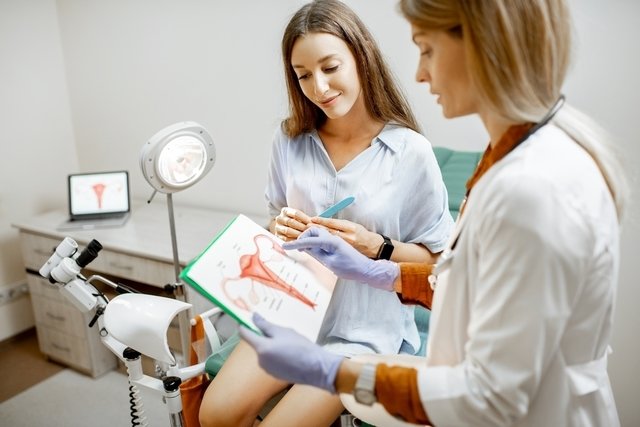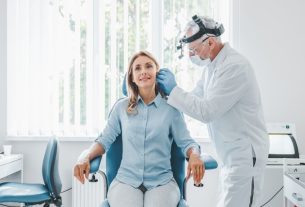Genital psoriasis is an autoimmune disease that affects the skin of the genital region, causing the appearance of smooth, dry-looking reddish spots in the intimate area.
This skin change can affect both men and women and can develop on any part of the genitals, including the pubis, thighs, buttocks, penis or vulva, for example.
Although there is no cure, the symptoms of genital psoriasis can be alleviated through treatment recommended by a dermatologist, who may recommend the use of corticosteroid medications and recommend wearing cotton underwear and keeping the area clean.

Main symptoms
The main symptoms of genital psoriasis are:
- Small, smooth, shiny red spots in the genital region;
- Intense itching at the site of the lesions;
- Dry skin;
- Local irritation.
Symptoms of genital psoriasis are more common in people who are overweight, being more intense when the person sweats and/or wears hot and tight clothes frequently.
Most affected locations
The main sites affected by genital psoriasis are:
- Pubis: the region just above the genitals, where the hair is located, presents symptoms similar to capillary psoriasis;
- Thighs: the wounds usually appear in the folds of the thighs, close to the genitals;
- Vulva: the spots are usually red and smooth and only affect the external part of the vagina;
- Penis: It normally appears on the glans, but can also affect the body of the penis. It is characterized by several small red spots, with scaly or smooth, shiny skin;
- Buttocks and anus: the wounds appear in the folds of the buttocks or near the anus, causing intense itching and can be confused with hemorrhoids;
- Axillas: symptoms worsen when wearing tight clothing and sweating;
- Breasts: They normally appear in the lower part of the breasts, the region where the skin is folded.
In men, genital psoriasis does not normally cause sexual dysfunction, however the partner may be worried, which may end up making the relationship difficult. Furthermore, some of the medications used in the treatment may have some side effects that make an erection difficult.
How to confirm the diagnosis
The diagnosis of genital psoriasis must be made by a dermatologist, gynecologist or urologist based on the assessment of the signs and symptoms presented by the person.
However, the doctor may also advise carrying out other exams and tests to screen for other possible problems that may be causing changes in the skin, such as fungal or bacterial infections, for example.
Make an appointment with the nearest doctor to have your symptoms assessed and treatment indicated if necessary:
Taking care of your health has never been easier!
How the treatment is carried out
The treatment of genital psoriasis must be guided by a dermatologist, who initially recommends the use of corticosteroid-based creams, such as Psorex, which should only be used in the affected region, according to the doctor’s instructions, to reduce skin inflammation and relieve the discomfort.
In more serious cases, where the wounds do not improve with the use of creams or when other regions of the body are also affected, the doctor may also prescribe the use of medications, such as dapsone and methotrexate, for example.
Another alternative is ultraviolet light therapy, which are UVA and UVB rays, which must be carried out in specialized dermatologist clinics, and the duration and number of sessions depend on the person’s skin type and severity of the lesions. Better understand what medications and other treatment options are available for psoriasis.
Care to recover faster
Some other tips to reduce skin irritation and recover faster are:
- Wear light cotton clothing that is not tight;
- Avoid sweating or applying psoriasis medications immediately after physical activity;
- Always keep the affected region clean;
- Avoid using perfumes, soaps and creams that are not recommended by your doctor;
- Avoid using scented pads, as they can irritate the skin;
- Wash the genital region to remove all medications before intimate contact;
- Use a condom and lubricate the area well during intimate contact;
- Wash the area well after intimate contact and reapply the medication.
It is also important to remember that tar-based ointments for psoriasis should only be applied to the genital region according to medical advice, as excessive use can cause irritation and worsen the lesions.
Bibliography
- NPF. Genital Psoriasis. Available at: <https://www.psoriasis.org/about-psoriasis/specific-locations/genitals>. Accessed on April 9, 2019
- PSORIASIS AND PSORIATIC ARTHRITIS ALLIANCE (PAPAA). Genital psoriasis. Disponível em: <https://www.papaa.org/learn-about-psoriasis-and-psoriatic-arthritis/psoriatic-disease-unlocked/genital-psoriasis/>. Acesso em 28 jun 2023
- DERMNET DERMATOLOGY RESOURCE. Genital psoriasis. Available at: <https://dermnetnz.org/topics/genital-psoriasis>. Accessed on June 28, 2023
- AMERICAN ACADEMY OD FERMATOLOGY ASSOCIATION. How can I treat genital psoriasis?. Available at: <https://www.aad.org/public/diseases/psoriasis/treatment/genitals/genital-treat>. Accessed on June 28, 2023

Sign up for our newsletter and stay up to date with exclusive news
that can transform your routine!
Warning: Undefined array key "title" in /home/storelat/public_html/wp-content/plugins/link-whisper-premium/templates/frontend/related-posts.php on line 12
Warning: Undefined array key "title_tag" in /home/storelat/public_html/wp-content/plugins/link-whisper-premium/templates/frontend/related-posts.php on line 13




